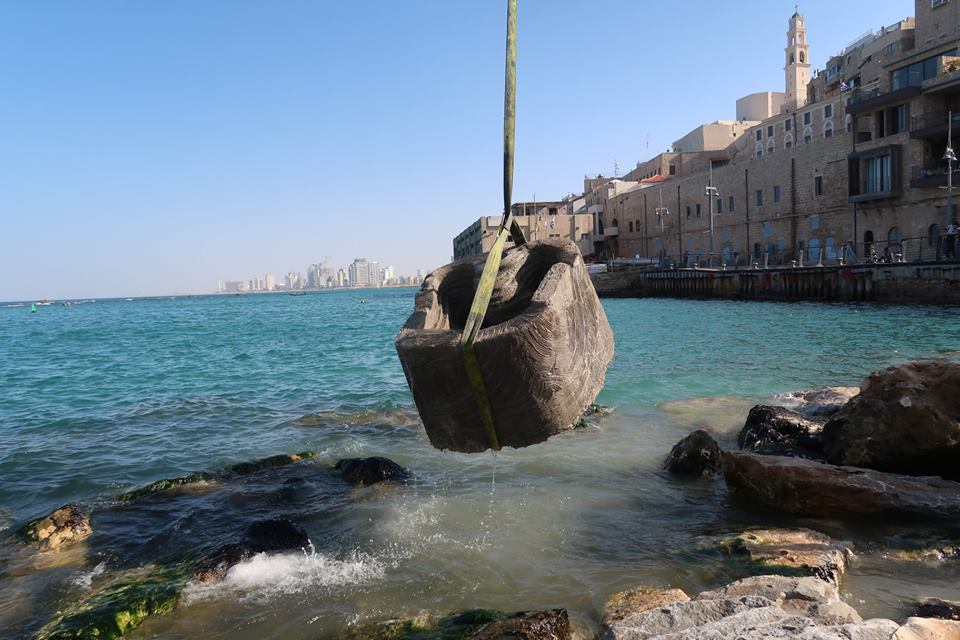As human invasion of coasts and marine space is inevitable, our planet faces several problems in increased storminess and sea level rise. Can ecological engineering help?
The way humans are invading the oceans doesn’t seem to be stopping. In February the city of Tel Aviv, Israel moved to increase marine biodiversity in its shores with the help of underwater concrete structures.
CTECH reported that the Atarim Group, which oversees the development of Tel Aviv’s coastline areas, had joined hands with Israeli-based startup ECOncrete Tech Ltd., which develops eco-friendly underwater structures.
The Sociable spoke to Dr. Shimrit Perkol-Finkel, CEO of ECOncrete Tech, ahead of the Horasis Global Meeting taking place in Cascais, Portugal, from April 6-9, where she is a speaker.

Dr. Shimrit Perkol-Finkel
“We absolutely cannot continue armoring our coastlines and destroying precious natural habitats without integrating ecological considerations that allow for more sustainable development”
Read More: 800 world leaders to explore a ‘more morally decent form of globalization’ at Horasis
Dr. Perkol-Finkel has worked towards developing ecological engineering to help reduce the ecological footprint of coastal infrastructure like breakwaters, seawalls, ports, and piers.
“I believe that we absolutely cannot continue armoring our coastlines and destroying precious natural habitats without integrating ecological considerations that allow for more sustainable development,” she says.
In an ideal scenario, we would stop developing and allow for managed realignment of our coasts and let natural coastal barriers, like oyster reefs, coral reefs, and marsh lands, deal naturally with sea level rise.
However, with over half of the world’s population (and growing) residing along coastlines, which represent 15% of the earth’s land surface, coastal development is not expected to stop.
“The least we can and must do is use innovative technologies that reduce the impact and maximize the ecological value of man-made structures along coastlines and offshore,” she says.
How Can Ecological Engineering Help Coastlines?
Dr. Perkol-Finkel co-founded ECOncrete with Dr. Ido Sella in 2012. With the help of bio-enhancing concrete solutions that are strong, cost-effective, and low-carbon, the company protects and rejuvenates coastlines and marine resources, setting an example for effective ecological engineering.
Ecological engineering is the designing of sustainable ecosystems that integrate human society with its natural environment for the benefit of both. The field has shown much promise over the last 30 years, and in the last decade, even more so.
“The least we can and must do is use innovative technologies that reduce the impact and maximize the ecological value of man-made structures along coastlines and offshore”
This branch of engineering aims to restore ecosystems that have been considerably ravaged by human activities. It also aims to develop new sustainable ecosystems with both human and ecological values. In the face of diminishing conventional energy sources the need for ecological engineering becomes especially important.
“By integrating environmentally sensitive technologies like those developed by ECOncrete, we can increase the biological productivity and value of ecosystem services gained by the structure,” says the ECOncrete CEO.
“While standard ‘gray’ concrete structure in the marine environment are typically barren or dominated by nuisance and invasive species, bio-enhanced structures can support rich and diverse marine life with more fish, oysters, corals and more,” she adds.
Read More: Embracing the power of Earth with green geothermal energy
Dr. Perkol-Finkel reveals that such ecological structures allow us to gain the ecological benefits without compromising structural performance of a coastal infrastructure. In fact, biological growth can help increase the strength of the concrete and make it more adaptive to climate change in a process called bio-protection.
Why Ecological Engineering is Generating Interest
In her research paper, Ecologically Active Concrete for Coastal and Marine Infrastructure: Innovative Matrices and Designs, Dr. Perkol-Finkel, along with Dr. Sella, presents results from a year-long experimental study that evaluates the performance of ecologically active concrete matrices and designs for coastal and marine construction.
Their results indicate that introducing slight modifications in concrete composition and surface texture can improve the capabilities of concrete based coastal and marine infrastructure (CMI) to support enhanced marine fauna and flora. It can also provide valuable ecosystem services with economic advantages such as elevated water quality, increased operational life span, structural stability, and absorption of hydrodynamic forces.
“Ecological engineering can significantly reduce the mitigation requirements and facilitate project permitting”
Dr. Perkol-Finkel says the constant increase in level of interest and acceptance of ecological engineering concepts over the past few years has surprised her. One of the reasons for generating such interest is super storms and extreme weather events.
After Superstorm Sandy destroyed the Sandy Hook Pilots Association’s Staten Island headquarters in 2012, they rebuilt a more resilient facility with storm-resilient materials such as a zinc-titanium exterior that withstands future climate conditions, removes old debris and historic fill, and avoids building into the water.
Another reason that has been proving to be a strong driver to arm coastlines is increased understanding of the need in sustaining marine resources.
“There is a global push to comply with the UN Sustainable Development Goals (SDGs) and environmentally sensitive technologies,” says Dr. Perkol-Finkel.
ECOncrete, for example, contributes to several of the UN SDGs, such as Life Below Water and Climate Action. Also, through innovative production techniques, it contributes to Industry Innovation and Infrastructure and Responsible Consumption and Production.
An environmentally aware youth is also taking a real interest in the field of ecological engineering.
“I see a lot of interest by young people in the field. I actually feel that young professionals are much more open minded to innovation, especially in highly conservative and traditional industries. Plus, there seems to be an overall (ageless) interest in conserving our oceans, and an increased realization that things must change,” says the ECOncrete co-founder.
Do regulations help?
Dr. Perkol-Finkel reveals that the regulatory climate also helps in welcoming these ideas. Strict regulations can encourage investment in ocean-friendly coastal infrastructure. In the US, for example, there are strict mitigation requirements enforced on any coastal/marine development project.
Read More: Turning the tide on plastic pollution: 5 green innovators you should check out in 2019
“Ecological engineering can significantly reduce the mitigation requirements and facilitate project permitting. With the right technologies and designs, the structures generated can offer viable habitat that accounts for on-site mitigation,” she explains.
“There is a global push to comply with the UN Sustainable Development Goals (SDGs) and environmentally sensitive technologies”
Much interest is also being seen from national and international maritime associations like the NY Metropolitan Waterfront Alliance, which developed the Waterfront Edge Design Guidelines (WEDG). Another such organization is the World Ports Sustainability Program (WPSP), which promotes environmentally sensitive approaches in working waterfronts.
These regulations do not exist in Europe, and many other countries only demand an environmental impact statement and no mitigation.
“However, I feel there is a shift towards including ecological engineering and ‘greening’ or ‘blueing the grey’ as part of large scale coastal development schemes even in countries that don’t have direct mitigation policies, such as Netherlands, France, the UK, and Hong Kong,” she explains.
Challenges Remain
Located off the Florida coast, the Osborne Reef was built in the 1970s with old tires in a bid to build an artificial reef, but the ecological operation miscarried miserably. While hurricanes and tropical storms dislodged a majority of the tires, further damaged was recorded in all the nearby coral reefs.
Such discoveries are being reported frequently, pointing to the dire need to improve our coastlines. According to Dr. Perkol-Finkel, there are several main challenges that must be urgently solved to achieve positive development in this area.
She stresses the need to start with a global effort to educate stakeholders, including policy makers, developers, engineers, landscape architects, and scientists, of the value of ecological engineering.
“Raising awareness of this emerging field is highly important, especially the need to integrate innovation in the traditional fields of construction and concrete,” she says.
A major challenge she cites is regulations: “We must develop, adopt and enforce binding policies, regulations and standards for building ‘blue’ along coastlines.”










